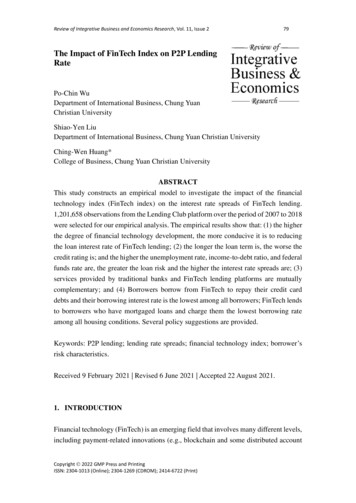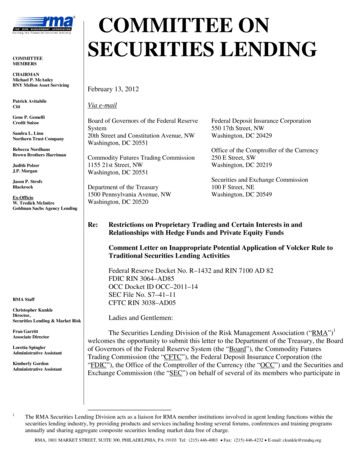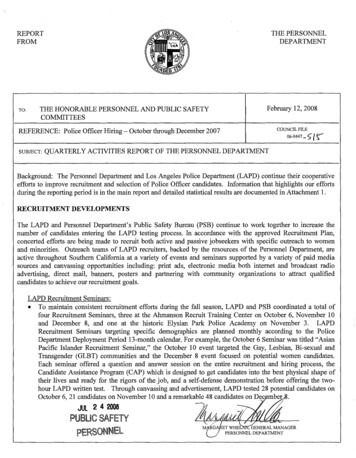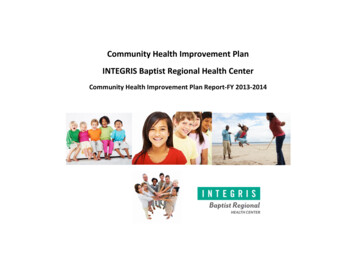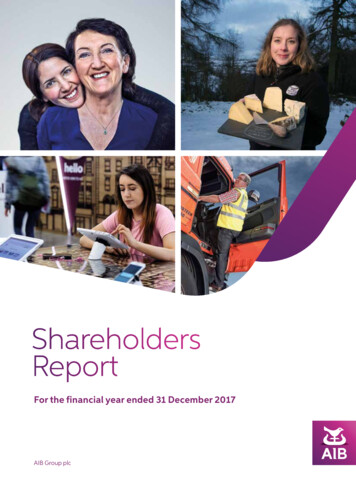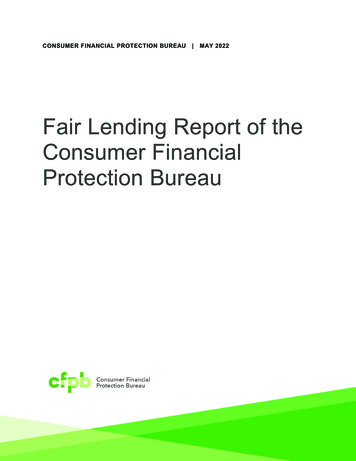
Transcription
CONSUMER FINANCIAL PROTECTION BUREAU MAY 2022Fair Lending Report of theConsumer FinancialProtection Bureau
Table of contentsTable of contents. 1Message from the Fair Lending Director. 21.2.3.Fair lending enforcement and supervision. 41.1Risk based prioritization .41.2Fair lending enforcement . 51.3Fair lending supervision.9Rulemaking and guidance . 102.1Rulemaking . 102.2Guidance . 12Stakeholder engagement . 183.1Promoting and broadcasting the fair lending and access to creditmission. 183.2Seeking information .223.3Data and reports .243.4 Interagency engagement . 274.Amicus program and other litigation . 305.Interagency reporting on ECOA and HMDA . 316.5.1Reporting on ECOA enforcement . 315.2Reporting on HMDA .36Conclusion . 38Appendix A: Defined terms . 391CONSUMER FINANCIAL PROTECTION BUREAU, MAY 2022
Message from theFair Lending DirectorStarting and owning a small business is the foundation ofdreams and aspirations. There is a certain dignity in knowingthe security and love of a stable, safe home in communityanchored by individuals and businesses invested in thecommunity’s success. Both starting a successful small businessand owning one’s home are key building blocks of individualand generational wealth. Yet, individuals and communities of color generally face barriers tofinancing their small businesses and homes that their white counterparts do not experience.These families and communities also own their homes at much lower rates than non-Hispanicwhites, and people of color who do own their homes are more likely to be at risk of foreclosure.This is due, in part, to a legacy of structural discrimination which extends to mortgage, auto,student, and other credit markets. The mission of fair lending is to break these discriminatorypatterns and practices and to promote access to credit to create fairer markets for all.This report covers the Consumer Financial Protection Bureau’s (CFPB) fair lending activitiesduring 2021. Much of the CFPB’s 2021 work centered on Acting Director Uejio’s call for theCFPB to take bold and swift action to address issues of pervasive racial injustice and long-termeconomic impacts of the COVID-19 pandemic on individuals and communities. In addition,Director Chopra has prioritized the CFPB’s foundations of financial inclusion, racial andeconomic equity, and fair competition. As a result, we focused our fair lending work on issuesespecially pertinent to people and communities of color and those at risk of losing their housingor unable to access credit for their small businesses. This work took various forms, utilizing allof the CFPB’s available tools, and touched nearly every market within our purview.Notably, this year we brought an enforcement action against Trustmark National Bank(Trustmark) for redlining in the Memphis Metropolitan Statistical Area (MSA). Trustmarkdiscouraged prospective applicants in Black and Hispanic neighborhoods, avoided locatingbranches or assigning loan officers to these communities, and failed to monitor its fair lendingcompliance. We continue to examine and investigate entities who are engaged in redlining, aswell as mortgage pricing discrimination. Additionally, public reports of racist practices in thehome appraisal industry led us to prioritize resources to ensure that the appraisals used to makelending decisions are accurate and free from bias. Redlining, pricing discrimination, andappraisal bias are significant barriers to fair competition in the mortgage market, impeding the2CONSUMER FINANCIAL PROTECTION BUREAU, MAY 2022
ability of an individual borrower to get credit on fair terms, thus stifling growth in communitiesacross the country.Home is not only the walls and beams of a house, but also the community that supports it. Fromthe small businesses that anchor our neighborhoods, to the family farms that dot thecountryside, these businesses are the drivers of opportunity in a community. In 2021, the CFPBtook the significant step of issuing a notice of proposed rulemaking (NPRM) for section 1071 ofthe Dodd-Frank Wall Street Reform and Consumer Protection Act (Dodd Frank Act), to collectcertain data on applications for credit for women-owned, minority-owned, and small businesses.The need for this data was highlighted in 2020 and in 2021, as small businesses were hitespecially hard by the COVID-19 pandemic, and as Black and Hispanic entrepreneurs facedheadwinds in accessing small business credit compared to their white counterparts. The datacollection intended with this proposed rule will allow the CFPB, advocates, industry, and otherstakeholders to better monitor small business markets and community development needs tofoster an inclusive and competitive small business lending market.Some bad actors target and exploit at-risk communities. In 2021, the CFPB sued Libre by Nexus(Libre) and JPay for engaging in unfair, deceptive, or abusive acts and practices. Libre targetedimmigrants held in detention centers for a services scam that traps victims into payingexpensive, long-term fees. JPay provided financial services to prisons and jails nationwide,charging unfair fees to their customers. In the United States, incarcerated individuals andindividuals reentering society are overwhelmingly men of color. The CFPB will continue to fightdiscrimination that manifests as unfair, deceptive, or abusive acts and practices.I am encouraged by the possibility of utilizing vehicles like special purpose credit programs toexpand access to credit, but skeptical of claims that advanced algorithms are the cure-all for biasin credit underwriting and pricing. Home is a place, home is a feeling, home shapes the peopleour children become. I am proud of what the CFPB achieved in 2021, our tenth year of existence,and I look forward to the future of fair lending and the next ten years, as we continue our workso that entrepreneurs have the pride of owning a successful small business and all individualshave the opportunity to know the comfort of a place worth calling home.Sincerely,Patrice Alexander Ficklin3CONSUMER FINANCIAL PROTECTION BUREAU, MAY 2022
1. Fair lending enforcementand supervision1.1 Risk based prioritizationBecause Congress charged the CFPB with the responsibility of overseeing many lenders andproducts, the CFPB has long-used a risk-based approach to prioritizing supervisoryexaminations and enforcement activity. This approach helps ensure that the CFPB focuses onareas that present substantial risk of credit discrimination for consumers. 1As part of the prioritization process, the CFPB identifies emerging developments and trends bymonitoring key consumer financial markets. If this field and market intelligence identifies fairlending risks in a particular market, that information is used to determine the type and extent ofattention required to address those risks.The prioritization process incorporates a number of additional factors, including tips and leadsfrom industry whistleblowers, advocacy groups, and government agencies; supervisory andenforcement history; consumer complaints; and results from analysis of Home MortgageDisclosure Act (HMDA) and other data.As a result of its annual risk-based prioritization process for 2021, in 2021, the CFPB focusedmuch of its fair lending enforcement and supervision efforts on advancing the CFPB’s prioritiessurrounding racial and economic equity and promoting economic recovery related to theCOVID-19 pandemic.Additionally, the CFPB focused its fair lending supervision efforts on mortgage origination andpricing, small business lending, student loan origination work, policies and proceduresregarding geographic and other exclusions in underwriting, and on the use of artificialintelligence (AI) and machine learning models.As in previous years, the CFPB’s 2021 mortgage origination work continued to focus onredlining (and whether lenders intentionally discouraged prospective applicants living in, orseeking credit in minority neighborhoods from applying for credit); assessing whether there is14For additional information regarding the CFPB’s risk-based approach in prioritizing supervisory examinations, seeSection 2.2.3, Risk-Based Approach to Examinations, Supervisory Highlights Summer 2013, available athttps://files.consumerfinance.gov/f/201308 cfpb supervisory-highlights august.pdf.CONSUMER FINANCIAL PROTECTION BUREAU, MAY 2022
discrimination in underwriting and pricing processes such as steering; and HMDA data integrityand validation reviews (both as standalone exams and in preparation for Equal CreditOpportunity Act (ECOA) exams that will follow).The CFPB’s small business lending work looked to assess whether there are disparities inapplication, underwriting, and pricing processes, redlining, and whether there are weaknesses infair lending-related compliance management systems (CMS).Across multiple markets, the CFPB evaluated whether lenders maintain policies and proceduresthat exclude certain types of income or exclude property on the basis of geography inunderwriting decisions.The CFPB’s student loan origination work included a focus on lenders’ policies and practices inunderwriting or pricing for fair lending compliance. The CFPB also is expanding its evaluationof AI and machine learning models as used by institutions, including in evaluating applicants forcredit.1.2 Fair lending enforcementCongress authorized the CFPB to bring actions to enforce the requirements of eighteenenumerated statutes, including ECOA, HMDA, and Unfair, Deceptive, or Abusive Acts orPractices (UDAAP). The CFPB engages in research, conducts investigations, files administrativecomplaints, holds hearings, and adjudicates claims through the CFPB’s administrativeenforcement process. The CFPB also uses its independent litigation authority to file cases infederal court alleging violations of fair lending laws under the CFPB’s jurisdiction. Like otherFederal regulators, the CFPB is required to refer matters to the Department of Justice (DOJ)when it has reason to believe that a creditor has engaged in a pattern or practice of lendingdiscrimination. 21.2.1 Public enforcement actionsIn 2021, the CFPB announced four fair lending-related enforcement actions. These actions werebrought under ECOA as well as other federal consumer financial laws that protect consumersand ensure fair access to credit, including the Consumer Financial Protection Act of 2010(CFPA) and the Electronic Fund Transfer Act (EFTA). These actions included Trustmark25See 15 U.S.C. § 1691e(h).CONSUMER FINANCIAL PROTECTION BUREAU, MAY 2022
National Bank (Trustmark); LendUp Loans, LLC (LendUp); JPay, LLC (JPay); and NexusServices, Inc. (Libre by Nexus).TrustmarkOn October 22, 2021, the CFPB, together with DOJ, filed a complaint and proposed consentorder in the federal district court for the Western District of Tennessee in settlement of claimsagainst Trustmark, which is headquartered in Jackson, Mississippi. 3 The joint complaint allegedthat Trustmark engaged in unlawful discrimination against applicants and prospectiveapplicants, including by redlining majority Black and Hispanic communities in the MemphisMSA and engaged in acts and practices that would discourage prospective applicants fromapplying for credit in violation of ECOA, Regulation B, and the CFPA. In the joint complaint,DOJ also alleged that Trustmark’s conduct violated the Fair Housing Act (FHA).The consent order, as entered by the court on October 27, 2021, requires Trustmark to invest 3.85 million in a loan subsidy program that will offer qualified applicants for credit secured byproperties in majority Black and Hispanic neighborhoods in Memphis loans on a moreaffordable basis than otherwise available from Trustmark; open a new loan production office ina majority Black and Hispanic neighborhood in the Memphis MSA; fund targeted advertising togenerate applications for credit from qualified consumers in majority Black and Hispanicneighborhoods in Memphis; and take other remedial steps to improve its fair lendingcompliance and serve the credit needs of majority Black and Hispanic neighborhoods in theMemphis MSA. The order also requires Trustmark to pay a civil money penalty of 5 million, 4million of which would be remitted as a penalty paid to the Office of the Comptroller of theCurrency (OCC) for FHA violations arising from the same conduct alleged in the complaint.LendUp LoansOn September 8, 2021, the CFPB filed a lawsuit in the United States District Court for theNorthern District of California against LendUp Loans, LLC. LendUp is an online lender offeringsingle-payment and installment loans to consumers. 4 In addition to other violations ofconsumer protection laws, the CFPB alleged that LendUp failed to timely issue requiredadverse-action notices and failed to provide accurate denial reasons on its adverse-actionnotices to thousands of loan applicants, in violation of ECOA and Regulation B, and that theseviolations also constitute violations of the CFPA.3Consumer Fin. Prot. Bureau, Trustmark National actions/trustmark-national-bank/).4Consumer Fin. Prot. Bureau, LendUp Loans, ctions/lendup-loans-llc-2/).6CONSUMER FINANCIAL PROTECTION BUREAU, MAY 2022
On December 21, 2021, the CFPB filed a proposed stipulated final judgment and order to settlethe lawsuit, which the court entered on December 30, 2021. The order imposes an injunction,prohibiting LendUp from offering or providing consumer credit, or assisting others that areoffering or providing consumer credit; from collecting on, selling, or assigning outstandingsubject loans, or assisting others in doing so; from selling consumer information; and frommaking misrepresentations in the sale or collection of consumer debt, or assisting others indoing so. The order also imposes a 100,000 civil money penalty and requires the payment of 40.5 million in consumer redress, to be suspended upon payment of the civil money penaltybased on LendUp’s demonstrated inability to pay.JPayOn October 19, 2021, the CFPB ordered JPay to pay 4 million for consumer redress, prohibitedJPay from engaging in the illegal conduct found by the CFPB, and required JPay to pay a 2million civil money penalty.5 JPay, headquartered in Miramar, Florida, contracts with federal,state and local Departments of Corrections around the country to provide financial products andservices to incarcerated and formerly incarcerated individuals. JPay provided prepaid cards toformerly incarcerated individuals upon their release from prison or jail (JPay debit releasecard). The debit release cards contained the balance of funds owed to former inmates upon theirrelease, including their commissary money, as well as any “gate money,” which are entitlementsprovided pursuant to state or local law, policy, or regulation to ease transition to society afterrelease from prison or jail. The CFPB found that JPay violated EFTA and its implementingRegulation E by requiring consumers to establish an account with the particular financialinstitution that issued the JPay debit release card as a condition of receiving a governmentbenefit, namely their gate money. JPay’s violations of EFTA and Regulation E also constitutedviolations of CFPA. The CFPB also found that JPay engaged in unfair and abusive acts andpractices by causing fees to be imposed through its JPay debit release card on consumers whowere required to get a JPay debit release card to access the money owed to them at the time oftheir release from prison or jail. In addition, the CFPB found that JPay violated the CFPA’sprohibition against unfair acts and practices by causing some consumers to be charged fees ontheir JPay debit release card that were not authorized by their cardholder agreements, and theCFPA’s prohibition against deceptive acts and practices by misrepresenting fees of some JPaydebit release cards.Libre by Nexus57Consumer Fin. Prot. Bureau, JPay, LLC, ns/jpay-llc/).CONSUMER FINANCIAL PROTECTION BUREAU, MAY 2022
On February 22, 2021, the CFPB filed a lawsuit against Libre by Nexus (Libre).6 The CFPBalleges that Libre and its owners operated a scheme through which Libre offers to pay theimmigration bonds to secure the release of consumers held in federal detention centers inexchange for large upfront fees and hefty monthly payments, while concealing ormisrepresenting the true costs of its services. Specifically, the CFPB alleges that Libre and itsowners engaged in deceptive and abusive acts or practices in violation of the CFPA. The CFPBfiled its complaint jointly with the Attorneys General of Virginia, Massachusetts, and New York.The CFPB seeks an injunction, damages or restitution to consumers, disgorgement of ill-gottengains, and the imposition of civil money penalties.1.2.2 ECOA referrals to Department of JusticeThe CFPB must refer to DOJ a matter when it has reason to believe that a creditor has engagedin a pattern or practice of lending discrimination in violation of ECOA. 7 The CFPB may referother potential ECOA violations to DOJ as well. 8 In 2021, the CFPB referred two matters to DOJabout discrimination pursuant to section 706(g) of ECOA. The referrals involved discriminationin mortgage origination policies and mortgage origination pricing based on race and nationalorigin.1.2.3 Implementing enforcement ordersWhen an enforcement action is resolved through a public enforcement order, the CFPB(together with other government entities, when relevant) takes steps to ensure that therespondent or defendant complies with the requirements of the order. Depending on the specificrequirements of individual public enforcement orders, the CFPB may take steps to ensure thatborrowers who are eligible for compensation receive remuneration and that the defendant hascomplied with the injunctive provisions of the order, including implementing a comprehensivefair lending CMS.1.2.4 Pending fair lending enforcement investigationsIn 2021, the CFPB had a number of ongoing and newly opened fair lending investigations ofinstitutions. The CFPB investigated or is actively investigating potential discrimination inseveral markets, including student lending, payday lending, credit cards, small business lending,6Consumer Fin. Prot. Bureau, Nexus Services Inc., Et ctions/nexus-services-inc-et-al/).715 U.S.C. § 1691e(g).8Id.8CONSUMER FINANCIAL PROTECTION BUREAU, MAY 2022
mortgage lending, including the unlawful practice of redlining, and discrimination in mortgagepricing exceptions. In 2021, the CFPB also investigated issues with HMDA reporting. TheBureau is looking into potential discriminatory conduct, including under ECOA and unfairness,as well as unlawful conduct targeted at vulnerable populations.1.3 Fair lending supervisionThe CFPB’s Supervision program assesses compliance with Federal fair lending consumerfinancial laws and regulations at banks and nonbanks over which the CFPB has supervisoryauthority. As a result of the CFPB’s efforts to fulfill its fair lending mission during 2021, theCFPB initiated 31 fair lending examinations or targeted reviews.For supervisory communications issued by Supervision during 2021, the most frequentlyidentified issues related to the CFPB’s Prioritized Assessments. Through PrioritizedAssessments, the CFPB continued to expand its supervisory approach to cover a greater numberof institutions than its typical examination schedule allows, gain a greater understanding ofindustry responses to pandemic-related challenges, and help ensure that entities are attentive topractices that may result in consumer harm. Certain Prioritized Assessments evaluated fairlending risks in the small business lending market.In 2021, the CFPB issued several fair lending-related Matters Requiring Attention, directingentities to take corrective actions that will be monitored by the CFPB through follow-upsupervisory events. Regarding Prioritized Assessment observations, examiners encouragedsmall business lenders to consider the fair lending risks associated with participation in thePaycheck Protection Program (PPP), further implementation of the PPP, and in any new lendingprogram, and to evaluate and address any risks.During 2021, informed by the Director’s priority to advance equity using all the tools Congressgave the CFPB, Supervision continued to develop and dedicate resources to those priorities. As aresult of this prioritization process, the CFPB focused additional fair lending supervision effortson various product lines, especially mortgage origination and small business lending.9CONSUMER FINANCIAL PROTECTION BUREAU, MAY 2022
2. Rulemaking and guidance2.1 RulemakingAs the CFPB focused on racial and economic equity and responding to the COVID-19 pandemic,the CFPB was active in rulemaking activities which are particularly critical for communities andindividuals of color, women, and those who struggled to pay their mortgages or access smallbusiness loans as a result of the impacts of the COVID-19 pandemic. In 2021, the CFPB alsoissued an NPRM on Section 1071 of the Dodd-Frank Act (“section 1071”) to collect smallbusiness lending data; participated in interagency rulemaking to improve quality controlstandards for automated valuation models (AVM); and issued a final rule to establish safeguardsfor mortgage borrowers coming out of COVID-19 related forbearances.The CFPB publishes an agenda of its planned rulemaking activity biannually, which is availableat: atory-agenda.2.1.1 Small business lending and data collection rulemakingIn the Dodd-Frank Act, Congress directed the CFPB to adopt regulations governing thecollection of small business lending data. Section 1071 amended ECOA to require financialinstitutions to compile, maintain, and submit to the CFPB certain data on applications for creditfor women-owned, minority-owned, and small businesses.Congress enacted section 1071 for the purpose of facilitating enforcement of fair lending lawsand enabling communities, governmental entities, and creditors to identify business andcommunity development needs and opportunities for women-owned, minority-owned, andsmall businesses.On September 1, 2021, the CFPB issued a proposed rule amending Regulation B to implementchanges to ECOA made by section 1071. 9 Consistent with section 1071, the CFPB proposed torequire covered financial institutions to collect and to report to the CFPB data on applicationsfor credit for small businesses, including those that are owned by women or minorities. Theproposal also addresses the CFPB’s approach to privacy interests and the publication of section1071 data; shielding certain demographic data from underwriters and other persons;9The proposal was published in the Federal Register on Oct. 8, 2021. See 86 FR 56356.10CONSUMER FINANCIAL PROTECTION BUREAU, MAY 2022
recordkeeping requirements; enforcement provisions; and the proposed rule’s effective andcompliance dates.10More information is available at: https://www.consumerfinance.gov/1071-rule/, a pagecompiling key materials related to the section 1071 rulemaking.2.1.2 Automated Valuation Models rulemakingThe CFPB is participating in interagency rulemaking processes with the Federal Reserve Board(FRB), OCC, Federal Deposit Insurance Corporation (FDIC), National Credit UnionAdministration (NCUA), and Federal Housing Finance Agency (FHFA) (collectively, theAgencies) to develop regulations to implement the amendments made by the Dodd-Frank Act tothe Financial Institutions Reform, Recovery, and Enforcement Act of 1989 (FIRREA)concerning automated valuation models. The FIRREA amendments require implementingregulations for quality control standards for AVMs. These standards are designed to ensure ahigh level of confidence in the estimates produced by the valuation models, protect against themanipulation of data, seek to avoid conflicts of interest, require random sample testing andreviews, and account for any other such factor that the Agencies determine to be appropriate. In2021, under the process established by Congress in the Small Business Regulatory EnforcementFairness Act of 1996 (SBREFA), the CFPB began preparing the SBREFA process to consult withrepresentatives of small entities likely to be affected directly by the regulations the CFPB isconsidering proposing. To address potential fair lending risk in models, the CFPB is consideringproposing a requirement that covered institutions establish policies, practices, procedures, andcontrol systems to ensure that their AVMs comply with applicable nondiscrimination laws. TheAgencies will continue to work to develop a proposed rule to implement the Dodd-Frank Act’sAVM amendments to FIRREA.112.1.3 2021 Mortgage servicing COVID-19 ruleOn June 28, 2021, the CFPB issued a final rule amending certain provisions in Regulation X toreinforce equitable economic recovery as the federal foreclosure moratoria were phased out, tohelp protect borrowers from unwelcome surprises as they exited forbearance, to preventunnecessary foreclosures, and to support the housing market’s smooth and orderly transition to10Additional activity has occurred regarding this issue since the end of this reporting period: the comment period forthis proposed rule closed on January 6, 2022.11Additional activity has occurred regarding this issue since the end of this reporting period: on February 23, 2022,the CFPB published the Outline of Proposals and Alternatives Under Consideration for the Small BusinessAdvisory Review Panel for Automated Valuation Model Rulemaking. More information is available as-inhome-valuations/.11CONSUMER FINANCIAL PROTECTION BUREAU, MAY 2022
post-pandemic operation. 12 The rule established temporary special safeguards (which expired onJanuary 1, 2022) to help ensure that borrowers were evaluated for all options, including loanmodifications and selling their homes. Other temporary protections in the rule, such as aprovision permitting mortgage servicers to offer certain COVID-19-related streamlined loanmodifications based on the evaluation of an incomplete application, remain in effect. The rulecovers loans on principal residences and generally excludes small servicers. The rule took effecton August 31, 2021.2.2 GuidanceThe CFPB issues guidance to its various stakeholders in many forms, including interpretiverules, advisory opinions, statements, bulletins, publications such as Supervisory Highlights, andother resources to aid in compliance.In 2021, the CFPB released an interpretive rule confirming that ECOA’s prohibitions on sexdiscrimination extend to sexual orientation and gender identity; a statement on how to bestserve those who are limited English proficient; and a bulletin pertaining to supervision andenforcement priorities related to housing insecurity. The CFPB also published three issues ofSupervisory Highlights and a suite of resources pertaining to HMDA reporting and filing.2.2.1 Interpretive Rule regarding sexual orientation andgender identityOn March 9, 2021, the CFPB issued an interpretive rule stating that the prohibition against sexdiscrimination under ECOA and Regulation B includes sexual orientation discrimination andgender identity discrimination. 13 This prohibition also covers discrimination based on actual orperceived nonconformity with traditional sex- or gender-based stereotypes, and discriminationbased on an applicant’s associations. This interpretive rule explains that lenders cannotdiscriminate based on sexual orientation or gender identity, and is consistent with the SupremeCourt’s 2020 decision in Bostock v. Clayton County, Georgia, where the Court ruled that the12Consumer Fin. Prot. Bureau, Protections for Borrowers Affected by the COVID-19 Emergency Under the RealEstate Settlement Procedures Act (RESPA), Regulation X (Jun. 28, s/cfpb covid-mortgage-servicing final-rule 2021-06.pdf.Fin. Prot. Bureau, Equal Credit Opportunity (Regulation B), Discrimination on the Bases of SexualOrientation and Gender Identity (Mar. 9, 2021), https://files.consumerfinance.gov/f/documents/cfpb ecoainterpretive-rule 2021-03.pdf.13Consume
In 2021, the CFPB announced four fair lending-related enforcement actions. These actions were brought under ECOA as well as other federal consumer financial laws that protect consumers and ensure fair access to credit, including the Consumer Financial Protection Act of 2010 (CFPA) and the Electronic Fund Transfer Act (EFTA) .


